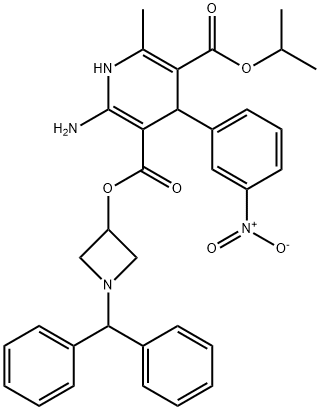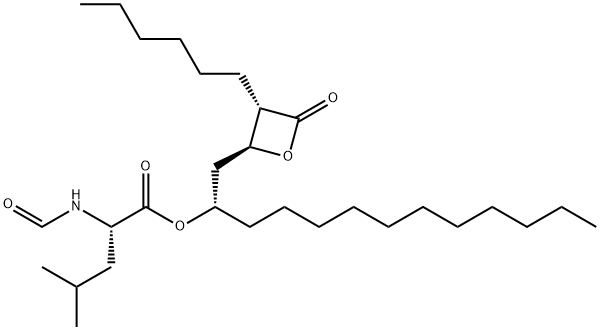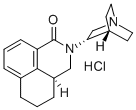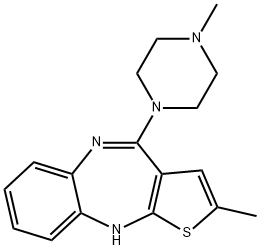Azelnidipine , ≥99% , 123524-52-7
Synonym(s):
2-Amino-1,4-dihydro-6-methyl-4-(3 nitrophenyl)-3,5-pyridinedicarboxylic acid 3-[1-(diphenylmethyl)-3-azetidinyl] 5-(1-methylethyl) ester;CS-905;RS-9054
CAS NO.:123524-52-7
Empirical Formula: C33H34N4O6
Molecular Weight: 582.65
MDL number: MFCD00865803
EINECS: 634-143-0
| Pack Size | Price | Stock | Quantity |
| 250MG | RMB120.80 | In Stock |
|
| 1G | RMB315.20 | In Stock |
|
| 5G | RMB1046.40 | In Stock |
|
| others | Enquire |
PRODUCT Properties
| Melting point: | 120-126°C |
| Boiling point: | 709.3±60.0 °C(Predicted) |
| Density | 1.33±0.1 g/cm3(Predicted) |
| storage temp. | Keep in dark place,Inert atmosphere,Room temperature |
| solubility | DMSO: >10mg/mL |
| pka | 7.89(at 25℃) |
| form | powder |
| color | Yellow |
| Merck | 14,907 |
| InChIKey | ZKFQEACEUNWPMT-UHFFFAOYSA-N |
| CAS DataBase Reference | 123524-52-7(CAS DataBase Reference) |
Description and Uses
Azelnidipine, a member of the 1,4-dihydropyridine class of L-type calcium channel blockers with a slow onset profile, was marketed in Japan for the treatment of hypertension. Azelnidipine is synthesized via the condensation of iso-propyl 2-(3- nitrobenzylidene)acetoacetate with (1-diphenylmethylazetidin-3-yl)-3,3-diamino acrylate. The diamino acrylate intermediate is prepared from the cyanoacetic ester by sequential treatment with HCl and ammonia. In receptor binding studies using porcine heart membrane fractions, azelnidipine exhibits an IC50 of 3.1 nM and an apparent Ki of 2.1 nM. Its tight binding and slow onset are correlated with its high lipophilicity. A slow onset is also noted in vitro in a rat aortic strip contraction assay, and this effect continues after removal of the drug from the bath solution. In the conscious spontaneously hypertensive rat (SHR) model of hypertension, it was more potent that nicardipine and also had a more gradual onset and long-lasting effect. This effect was noted both when dosed orally or intravenously. When SHR dosed at 1 or 3 mpk/day for 15 weeks, a sustained reduction in systolic blood pressure was noted (19 and 43 mmHg reduction, respectively). Cardiac output was increased and total peripheral resistance was decreased in each group. Clinical studies of patients with mild-to-moderate hypertension have shown that long-term treatment with azelnidipine provided a sustained decrease in blood pressure (mean reduction systolic /diastolic: 27.8/16.6 mmHg). It similarly controlled blood pressure, as did amlodipine at 24 h. It possesses a gradual onset of activity with plasma levels increasing before the antihypotensive effect is attained. After plasma levels drop, the pharmacodynamic effect is sustained. In clinical studies, azelnidipine did not show reflex tachycardia, a common side effect of this class. Most common side effects were facial flushing and headache, similar to other dihydropyridines. Azelnidipine is dosed orally once daily (8–16 mg), is rapidly absorbed in a dose-dependent fashion, and has a mean terminal half-life of 19.2 h (8 mg dosage p.o. for seven days). Uniquely, it possesses a 2-amino function associated with a longer half-life than related agents wherein this moiety is a methyl. The very highly lipophilic 3-carboxylic ester side-chain is purported to contribute to the gradual onset of activity and prolonged pharmacodynamic effect, unlike other drugs in this class. This compound exhibits a much less pronounced first-pass metabolic effect than nicardipine.
Azelnidipine is a dihydropyridine calcium channel blocker with antihypertensice activity. Azelnidipine is used for treating ischemic heart disease and cardiac remodeling after myocardial infarction. S tudies show that Azelnidipine ttreatment can reduce the risk of hyperglycemia induced metabolic disorders
Safety
| Symbol(GHS) |   GHS05,GHS07 |
| Signal word | Danger |
| Hazard statements | H302-H318 |
| Precautionary statements | P280-P301+P312+P330-P305+P351+P338+P310 |
| Hazard Codes | Xn |
| Risk Statements | 22-41 |
| Safety Statements | 26-39 |
| WGK Germany | 3 |
| RTECS | US7968332 |
| HS Code | 2933.79.1500 |
| Toxicity | LD50 in female, male mice, female, male rats (mg/kg): 785, 979, 1267, 1971 orally |





